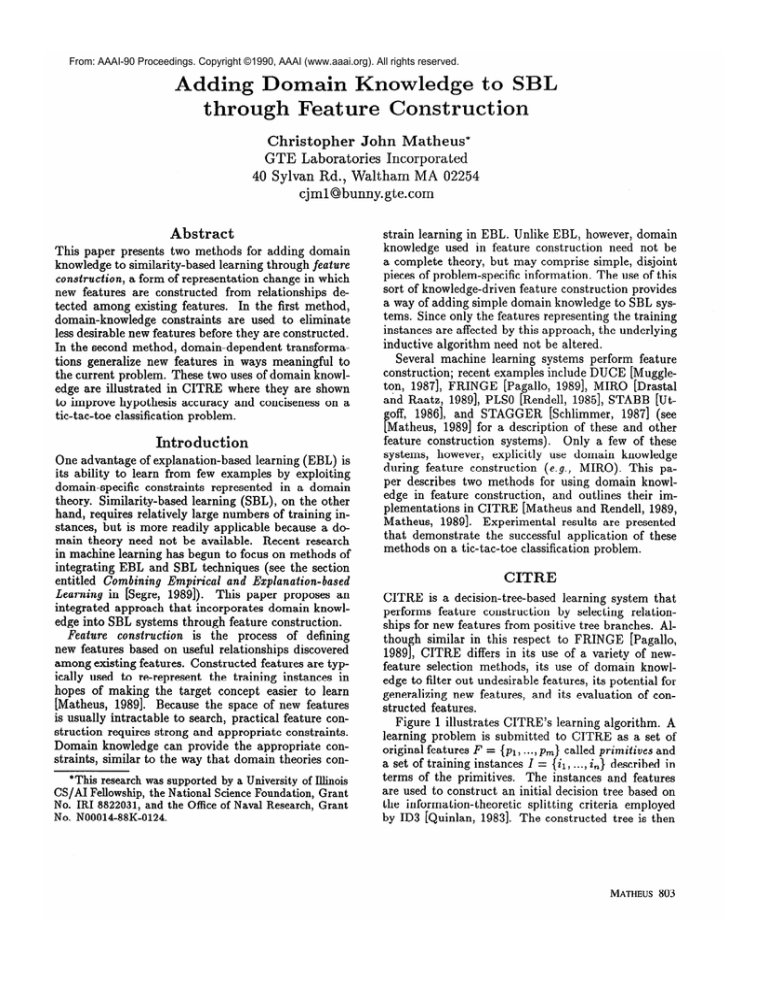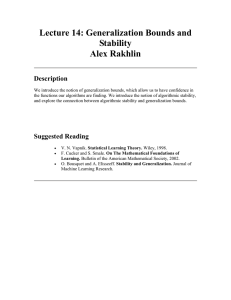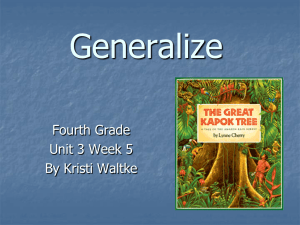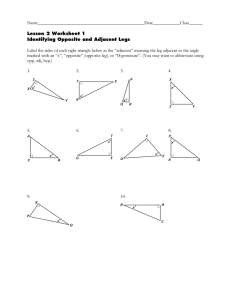
From: AAAI-90 Proceedings. Copyright ©1990, AAAI (www.aaai.org). All rights reserved.
Adding Domain Knowledge to SBL
through Feature Construction
Christopher John Matheus*
GTE Laboratories Incorporated
40 Sylvan Rd., Waltham MA 02254
cjml@bunny.gte.com
Abstract
This paper presents two methods for adding domain
knowledge to similarity-based learning through feature
construction,
a form of representation change in which
new features are constructed from relationships detected among existing features. In the first method,
domain-knowledge constraints are used to eliminate
less desirable new features before they are constructed.
In the second method, domain-dependent transformations generalize new features in ways meaningful to
the current problem. These two uses of domain knowledge are illustrated in CITRE where they are shown
to improve hypothesis accuracy and conciseness on a
tic-tat-toe classification problem.
Introduction
One advantage of explanation-based learning (EBL) is
its ability to learn from few examples by exploiting
domain-specific constraints represented in a domain
theory. Similarity-based learning (SBL), on the other
hand, requires relatively large numbers of training instances, but is more readily applicable because a domain theory
need not be available.
Recent
research
in machine learning has begun to focus on methods of
integrating EBL and SBL techniques (see the section
entitled Combining Empirical
and Explanation-based
Learning in [Segre, 19891). This paper proposes an
integrated approach that incorporates domain knowledge into SBL systems through feature construction.
Feature
construction
is the process of defining
new features based on useful relationships discovered
among existing features. Constructed features are typically used to re-represent the training instances in
hopes of making the target concept easier to learn
[Matheus, 19891. Because the space of new features
is usually intractable to search, practical feature construction requires strong and appropriate constraints.
Domain knowledge can provide the appropriate constraints, similar to the way that domain theories con“This research was supported by a University of Illinois
CS/AI Fellowship, the National Science Foundation, Grant
No. IRI 8822031, and the Office of Naval Research, Grant
No. N00014-88K-0124.
strain learning in EBL. Unlike EBL, however, domain
knowledge used in feature construction need not be
a complete theory, but may comprise simple, disjoint
pieces of problem-specific information. The use of this
sort of knowledge-driven feature construction provides
a way of adding simple domain knowledge to SBL systems. Since only the features representing the training
instances are affected by this approach, the underlying
inductive algorithm need not be altered.
Several machine learning systems perform feature
construction; recent examples include DUCE [Muggleton, 19871, FRINGE [Pagallo, 19891, MIRO [Drastal
and Raatz, 19891, PLSO [Rendell, 19851, STABB [Utoff, 19861, and STAGGER [Schlimmer, 19871 (see
fMatheus, 19891 for a description of these and other
feature construction systems). Only a few of these
systems, however, explicitly use domain knowledge
during feature construction (e.g., MIRO). This paper describes two methods for using domain knowledge in feature construction, and outlines their implementations in CITRE [Matheus and Rendell, 1989,
Matheus, 19891. Experimental results are presented
that demonstrate the successful application of these
methods on a tic-tat-toe classification problem.
CITRE
CITRE is a decision-tree-based learning system that
performs feature construction by selecting relationships for new features from positive tree branches. Although similar in this respect to FRINGE [Pagallo,
19891, CITRE d’
iff ers in its use of a variety of newfeature selection methods, its use of domain knowledge to filter out undesirable features, its potential for
generalizing new features, and its evaluation of constructed features.
Figure 1 illustrates CITRE’s learning algorithm. A
learning problem is submitted to CITRE as a set of
Flnst$;s-l)
=
aoriginal
set of features
tralnlng
PA cded
primitives
and
. .
.
= {il , . . . , ira} described in
terms of the primitives.
The instances and features
are used to construct an initial decision tree based on
the information-theoretic splitting criteria employed
by ID3 [Quinlan, 19831. The constructed tree is then
MATHEUS 803
Decision Tree
Construction
F = 1 plP-
Feature
Construction
PJ
I = { i,.. iII)
I
I
I
I -----------------
-I
Figure 1: Illustration of CITRE’s
..
learning algorithm.
pruned using pessimistic pruning [Quinlan, 19871, and
passed as input to CITRE’s feature-construction module. New features are constructed by selecting relationships from the decision tree as described below. The
new features F* are added to the active feature set, and
the entire process is repeated. This iterative learning
algorithm terminates when either the current tree contains no positive branches consisting of more than one
feature, or all potential new features from the current
tree are already present in the active feature set. Although the version of CITRE described in this paper
constructs only Boolean features, the system is capable of working with learning problems having nominal,
ordinal, or continuous-valued primitives.
Feature
Construction
in CITRE
Feature construction can be viewed in terms of four
aspects (see [Matheus, 19891):
1. the detection of when new features are required
2. the selection of relationships used to define new features
3. the generalization
of new features
4. the global evaluation
of constructed features
Descriptions of CITRE’s approach to detection, selection, and evaluation can be found in [Matheus and
Rendell, 1989, Matheus, 19891. This paper focuses on
CITRE’s methods of domain-knowledge filtering during selection and new-feature generalization.
During selection, CITRE selects pairs of Boolean relations (i.e., feature-value pairs) from the nodes in positively labeled branches of a decision tree, and conjoins
them to form new Boolean features, e.g., and(coZor =
red, size = big). This selection is achieved by one of
five methods: root, fringe, root-fringe, adjacent, or all.
The root method selects the relations in the first two
nodes of each positive branch, the fringe method selects the last two (i.e., the method used by FRINGE),
the root-fringe method selects both root and fringe
pairs, the adjacent method selects all adjacent pairs
along each branch, and the all method selects every
possible combination of feature pairs along each individual branch. The adjacent selection method was
used for the experiments described in this paper (see
[Matheus, 19891 for comparisons of other methods).
804 MACHINELEARNING
The selected pairs of relations are passed through a
filter eliminating pairs that do not
satisfy the constraints imposed by the available domain knowledge. Domain knowledge is represented in
CITRE as predicates that define relationships required
of all selected pairs. For example, in the tic-tat-toe
experiments described below, information about piece
adjacency was encoded as a domain-knowledge constraint restricting operands to pairs of spatially adjacent features. A virtually unlimited number of domainknowledge constraints may be defined in this way. On
the other hand, domain-knowledge constraints are not
required; in their absence, all selected relation pairs
are used to define new features.
Domain-knowledge filtering reduces the space of new
features and can result in a more tractable space containing a higher percentage of useful features. Unlike
a domain theory in EBL, CITRE’s constraints need
not define complete relationships between the goal concept and the primitives. As a result, simple commonsense types of information can be made available to
the learning algorithm, e.g., in board games spatial
proximity is often an important factor.
After selection, CITRE performs feature generulization using domain-dependent generalization operators.
The available generalization operators are applied sequentially to each potential new feature, resulting in
one or more generalized new features. In the tic-tat-toe
experiments, four generalization operators were used
to spatially translate candidate features up, down, left,
and right on the game board. This process of feature
generalization can help identify potentially useful features more quickly and with fewer training examples.
As with filtering, all available domain knowledge is applied to every new feature.
Together, domain-knowledge filtering and generalization operators provide a simple, systematic method
for incorporating specific domain knowledge into feature construction, and thereby into the SBL inductive processes. As the experiments in the next section demonstrate, the addition of domain knowledge
in this way can result in significant improvements in
hypothesis accuracy, hypothesis conciseness, and overall learning time.
domain-knowledge
Tic-tat-toe
Classification
The use of domain knowledge in CITRE is demonstrated in this section on a tic-tat-toe classification
problem. This learning problem was selected because
of the disjunctive form of the target concept (which
poses difficulties for many SBL algorithms), and because of the availability of simple domain knowledge
relevant to board games. The target concept for this
classification problem is “a win for x.” The feature
set comprises nine nominal primitives corresponding to
the nine board locations (labeled pll, ~12, ~13, ~21,
~22, ~23, ~31, ~32, and p33 in Figure 2). All features
range over the values of x, o, and blank. Using these
win for x
win for 0
loo-
draw
90 80 60
70Figure 2: The tic-tat-toe board on the left shows the
feature labels for each of the nine board squares. Examples of win for x, win for o, and draw are shown
to the right. Below each example is the number of instances of that type found in the set of all obtainable,
final tic-tat-toe boards.
,-lc-::::j
0
100
200
300
400
500
Number of Training Examples
80
primitives, the target concept can be expressed by the
following disjunctive relationship: [(pll = 2) A (~12 =
z)A(p13 = zc)]V[(p21 = z)A(p22
%)A@32
z)]V[(pl2
z)A(p33
= z)A(p33
= 4A(p22
= e)]V[(pll
= s)]V[(pll
= z)A(p23
= ~)A@21
= z)A(p32
= z)]V[(pl3
= s)A(p22
= ~)A@33
60
40
= z)]V[(p31
=
= z)A(p31
=
20
= z)A(p23
=
0
= e)]V[(pl3
0
=
c) A (~22 = z) A (~31 = z)].
Although the instance space defined by the nine features has cardinality 3’ = 19,.683, the rules for tic-tactoe permit only 958 final tic-tat-toe boards, of which
626 are wins for x, 316 are wins for o, and 16 are draws
(see Figure 2). This entire set of instances was used
as the test set in all experiments. Ten training sets for
each of five training sizes (100, 200, 300, 400, and 500
examples) were randomly drawn from this set.
For each independent variable tested in the experiments below, ten test runs were made at each of the
five training sizes while the following dependent variables were recorded: 1) accuracy of the final hypothesis
on classifying the test-set instances, 2) length of the final hypothesis measured as the number of primitives
required to define all internal nodes, and 3) CPU time
consumed during the entire learning process. These
recorded values were averaged and statistically analyzed using a t-test with 95% confidence intervals.
CITRE
without
Domain
Knowledge
CITRE was run without domain-knowledge filtering or
generalization in this first series of experiments. The
results are shown in Figure 3 for the adjacent method
and for the decision-tree algorithm without feature
construction (referred to as the none method). Feature construction improves accuracy by greater than
15% at the higher training sizes. The final hypotheses, however, are less concise. Although part of this
increase in length is due to the additional nodes required to improve hypothesis accuracy, the adjacent
method produces excessively long final hypotheses at
the higher training sizes (for example, at training size
400, final hypotheses are at least twice as long as necessary for the corresponding level of accuracy). CPU
times are also much greater than those for the none
100
1
200
I
300
I
I
400
500
Number of Training Examples
10
8
6
4
2
0
0
100
200
300
400
500
Number of Training Examples
Figure 3: Results of CITRE’s application to tic-tactoe classification without the use of domain knowledge:
* = adjacent, o = none.
method (over 700 times as much at training size 500).
This increase is due to the additional time required to
construct new features and to re-run the tree-induction
procedure over several generations. In summary, the
adjacent method alone improves accuracy significantly
but results in lg?s concise hypotheses and requires large
amounts of CPU time.
Domain-Knowledge
Filterjng
The next series of experiments tested the use of
domain-knowledge filtering by adding two knowledge
constraints: piece adjacency and piece type.
Piece
adjacency encodes the importance of piece proximity
in board games by constraining new features to relations between features physically adjacent on the game
board (e.g., pll and ~12, but not pll and ~13). PieceMATHEUS 805
A
E
U
:
;
90
80
70
600
100
0
200
300
400
500
Number of Training Examples
;
40
20
0
100
0
200
300
500
400
Number of Training Examples
10
$
u
8
6
Feature
- 00
0
100
200
300
400
500
Number of Training Examples
Figure 4: Results with the addition of domainknowledge filtering: o = adjacent + filtering, 0 =
adjacent
+ filtering with deferred pruning, * =
adjacent,
out filtering. Although the hypothesis lengths and
CPU times are substantially reduced, these improvements are less meaningful in light of the lower accuracy. This poorer performance suggests that the constraints imposed by the domain knowledge were perhaps too restrictive, preventing the construction of
useful features. However, although some potentially
useful features would have been filtered out for failure to satisfy the piece-adjacency and piece-type constraints, the most useful features were still realizable
(e.g., and(pl1
= x, and(p22
= x,p33
= x))).
The
reason more of these features were not constructed is
that the pruning of trees during feature construction
severely reduces the length of positive branches, and
thereby the pool of potential new feature (the effects
of pruning are discussed more fully in [Matheus, 19891).
To overcome this problem, an approach was implemented in which pruning is deferred until after the final tree is constructed. - With this approach
feature
-construction operates on all the information in the unpruned trees, while the benefits of pruning are maintained in the final hypotheses. The results of deferred
pruning tests are graphed as the @ plots in Figure 4.
For filtering, deferred pruning greatly improves accuracies and has insignificant effects on conciseness and
learning time. These results compare favorably with
the accuracy results of the pure adjacent method (i.e.,
the * plot in Figure 4).
o = none.
type knowledge encodes the importance of distinguishing between the players of the game (Z versus o) by
constraining new features to relations between features
possessing the same value (e.g., pl 1 = x and p12 = x,
but not pll = x and ~12 = 0). New features were required to satisfy both domain-knowledge constraints.
Although these pieces of domain knowledge are relevant to a larger class of board-game problems, the
specific predicates that defined them in these experiments were tailored for tic-tat-toe.
Figure 4 compares the domain-knowledge filtering
results to the previous experiment. Feature construction with filtering improves hypothesis accuracy (significant at size 500), however, the improvement is much
less than was achieved with the adjacent method with806 MACHINE LEARNING
Generalization
In the next series of experiments new features were generalized by spatially translating them up, down, left,
and right on the game board. All translations were
made in a single direction but could be extended up
to two places in distance. As a result, the minimum
number of new features generalizable from a single new
feature was zero and the maximum was three. Figure 5 shows the new feature and(pl1 = x,p21 = x)
translated one place down, one place to the right, and
two places to the right, resulting in three new features:
and(p21 = x, ~31 = x), arid(pl2 = x,p22 = x), and
xlX
+-I-
Figure 5: An example of the spatial translations used
in feature generalization.
The constructed feature
and(pl1 = x,p21=
x) is translated down one square,
right one square, and right two squares to produce
three new features.
= x, ~23 = x). Although the predicates used
to perform the generalizations are specific to tic-tactoe, spatial translations of this sort are relevant to a
wide range of learning problems.
and(pl3
As shown in Figure 6, generalization improves accuracy by more than 18% relative to the control method
(except at training size loo), and by as much as 10%
over the adjacent method alone. Conciseness is not
significantly affected by generalization, as the final hypotheses continue to be longer than necessary. CPU
times, however, increase to more than 1000 times that
required by the control method at size 500. The improved accuracy achieved with generalization would be
attractive if conciseness and CPU times could be improved. This situation suggests a combined approach
using generalization and domain-knowledge filtering.
Combining
Filtering
and Generalization
The final experiment combined domain-knowledge filtering and feature generalization.
The results are
graphed in Figure 7 along with plots for the adjacent
method without filtering or generalization and the
The combined method significantly
none method.
improved hypothesis accuracy relative to the control
method. Although the accuracies are slightly less than
those achieved by generalization alone (except at training size loo), they are slightly better than achieved
As hoped for, the combined
with filtering alone.
method achieves these improved accuracies while reducing hypothesis length and learning times relative
to the individual methods of filtering and generalization.
100
100
90
A
:
1
U
k
$
80
70
80
70
60
1
60 -II
O
90
I
100
I
200
I
300
I
400
lb0
260
3io
4bo
560
Number of Training Examples
I
500
Number of Training Examples
0
O&
0
100
200
300
400
100
200
300
400
500
Number of Training Examples
500
Number of Training Examples
10
8
6
4
H
;
Ei
4
2
0
0
0
100
200
300
400
500
Number of Training Examples
Figure 6:
8
6
0
2
adjacent
g
u
Results with feature generalization: e =
+ generalization, * = adjacent, o = none.
100
200
300
400
500
Number of Training Examples
Figure 7: Results for the combined use of generalization and domain-knowledge filtering: * = adjacent
+ generalization + filtering (with deferred pruning),
* = adjacent, o = none.
MATHEUS 807
Acknowledgments
Conclusions
An approach was presented for incorporating domain
knowledge into SBL through feature construction. Its
use was demonstrated in a version of CITRE that incorporates domain knowledge during feature construction in two ways: as constraints on the types of features
that may be constructed, and as transformations for
generalizing new features. In empirical tests on tic-tactoe classification, domain knowledge used in this way
improved hypothesis accuracy and conciseness, and reduced the computational costs of feature construction.
This approach offers two main advantages. First,
because the domain knowledge is used in feature construction, the underlying inductive algorithm is not affected. As a result, this approach should be readily
applicable to existing SBL systems through the addition of a feature construction component. Second,
this approach works with domain knowledge ranging in
quality from irrelevant information to complete domain
theories. When the domain knowledge is inappropriate, few if any useful features will be constructed and
performance will fall to the level achievable using the
primitives alone. With complete domain knowledge,
useful features can be constructed from few examples
and optimal accuracy and conciseness can be achieved.
The specific results of CITRE’s application to tictat-toe classification were presented to demonstrate
the central idea of using domain knowledge during feature construction. There are many improvements that
could be made both to the general approach and to
the specific techniques used in CITRE. In particular,
the use of domain-knowledge filtering as described in
this paper is rather rigid: if a new feature is inconsistent with the knowledge, it is not constructed. A
more flexible approach would use knowledge as a guide
for suggesting new features while retaining the ability to construct features unanticipated by the domain
knowledge. For example, when the domain-knowledge
filtering constraints were found to be too severe in the
second experiment, the constraints might have been relaxed to permit the construction of additional features.
This idea is evident in MIRO [Drastal and Raatz, 19891
where domain knowledge used to construct new features is retracted if the active features do not permit
the construction of a consistent hypothesis.
Another issue that deserves further consideration is
the generalization of new features. The method used
in the tic-tat-toe experiments is very primitive: a feature is translated into features having a similar level
of descriptive power (i.e., at the same level of generalization). A true generalization would, for example,
take a feature that detects an x in the first and second squares and generalize it to a feature that detects
an occurrence of two x’s side-by-side anywhere on the
board. Generalized features of this sort can lead to
faster learning from fewer examples, but because they
also increase the complexity of the search space, they
require even stronger constraints.
808 MACHINELEARNING
I would like to thank Chuck Anderson, Gunnar Blix,
Carl Kadie, Gregory Piatetsky-Shapiro, Larry Rendell,
Hong Shinn, Bernard Silver, and Richard Sutton for
their helpful comments and suggestions during preparation of this paper.
References
Drastal, George and Raatz, Stan 1989. Learning in
an abstract space. Technical Report DCS-TR-248,
Department of Computer Science, Rutgers University.
Matheus, Christopher J. and Rendell, Larry A. 1989.
Constructive induction on decision trees. In Proceedings of the Eleventh International
Joint Conference
on Artificial Intelligence,
Detroit, MI. 645-650.
Matheus, Christopher J. 1989. Feature Construction:
An Analytic Framework and An Application to Decision Trees. Ph.D. Dissertation, University of Illinois
at Urbana-Champaign.
Muggleton, Steve 1987. DUCE, an oracle based approach to constructive induction. In Proceedings of
the Tenth International
Joint
cial Intelligence.
287-292.
Conference
on Artifi-
Pagallo, Giulia 1989. Learning DNF by decision
trees. In Proceedings of the Eleventh International
Joint Conference
on Artificial Intelligence,
Detroit,
MI. Morgan Kaufmann Publishers, Inc.
Quinlan, J. Ross 1983. L earning efficient classification
procedures and their application to chess end games.
In Machine Learning:
An Artificial Intelligence
Approach. Tioga Press, Palo Alto. 463-482.
Quinlan, J. Ross 1987. Simplifying decision trees. International
Journal
of Man-Machine
Studies
27:221-
234.
Rendell, Larry A. 1985. Substantial constructive
induction using layered information compression:
Tractable feature formation in search. In Proceedings of the Ninth International
Artificial Intelligence.
650-658.
Joint
Conference
on
Schlimmer, Jeffrey C. 1987. Incremental adjustment
of representations in learning. In Proceedings of the
Fourth International
Workshop
on Machine
Learning,
Irvine, CA. Morgan Kaufmann Publishers, Inc. 7990.
Segre, Alberto, editor 1989.
Sixth International
Workshop on Machine Learning. Morgan-Kaufmann,
Ithaca, NY.
Utgoff, Paul E. 1986. Shift of bias for inductive concept learning. In Machine Learning: An Artificial Intelligence Approach,
Vol II. Morgan Kaufmann Publishers, Inc., Los Altos, CA. 107-148.




